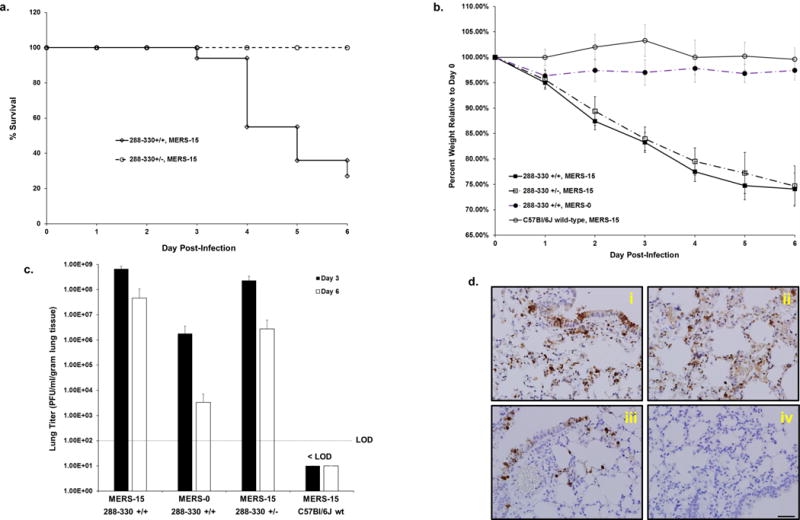Figure 2.

Mouse adapted MERS-CoV causes fatal disease in 288-330+/+ mice. Mice were inoculated intranasally with 5×106 PFU. (a) Mortality of 288-330+/− (n = 10) and 288-330+/+ (n = 16) mice was monitored daily through day 6 post-infection. Data reflect percent of surviving mice. (b) Mouse weights were measured daily through day 6 post-infection for 288-330+/+ + MERS-15 (n = 16); 288-330+/− + MERS-15 (n = 10), 288-330+/+ + MERS-0 (n = 10), and C57Bl/6J wt + MERS-15 (n = 7). Data are daily averages of the percent weight relative to day 0 ±SD. (c) Viral lung titers for MERS-CoV were determined at day 3 (n = 4 for 288-330+/− + MERS-15; n = 5 for 288-330+/+ + MERS-15; n = 5 for 288-330+/+ + MERS-0; n = 4 for C57Bl/6J wt + MERS-15) and day 6 (n = 4 for 288-330+/− + MERS-15; n = 4 for 288-330+/+ + MERS-15; n = 5 for 288-330+/+ + MERS-0; n = 3 for C57Bl/6J wt + MERS-15) post-infection. The limit of detection (LOD) is indicated. Bars are averages +SD. (d) Immunohistochemistry of lung sections for anti-MERS nucleocapsid at 3 days post-infection. 288-330+/+ + MERS-15 (i); 288-330+/− + MERS-15 (ii); 288-330+/+ + MERS-0 (iii); and C57Bl/6J wt + MERS-15 (iv). IHC images are representative of at least 3 samples. Scale bars in lower right panels are 1mm.
